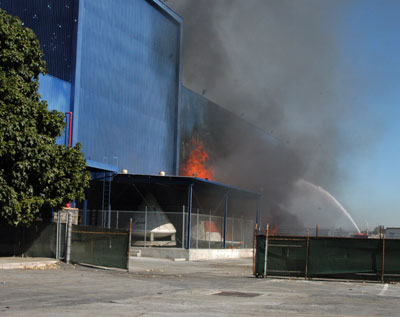The unforgettable fireby Dwayne A. Day
|
| Sometimes preservation can be dramatic, and a couple of weeks ago Downey’s aerospace past and film studio present intersected with a little bit of unexpected drama. |
The old aerospace site is gradually being reclaimed, with portions of it torn down and the land converted to other purposes including a hospital, a sports field, and a science center. Some of the old factory spaces are currently the location of the Aerospace Legacy Foundation, or ALF, dedicated to preserving the story of Downey’s aerospace heritage. The ALF is currently involved in trying to preserve two Apollo boilerplate capsules, one of which is owned by the City of Downey and the other owned by the Smithsonian. But sometimes preservation can be dramatic, and a couple of weeks ago Downey’s aerospace past and film studio present intersected with a little bit of unexpected drama.
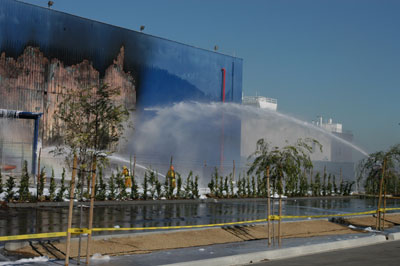 Firefighters extinguish a fire in Downey near two Apollo boilerplate capsules. (credit: Gerald Blackburn, Aerospace Legacy Foundation) |
The two capsules are designated BP-12 and BP-19. BP-12 was launched atop a Little Joe rocket during the Apollo program and used for emergency transonic flight tests. After it was no longer needed, it was retired to a site in front of a United Auto Workers union hall where it sat for over three decades. BP-19 was used for parachute tests and was dropped from the back of a C-133 cargo plane. It was displayed at the Apollo Park in Lancaster, California, north of Palmdale. Although outside, it was protected by a glass display case and is in better overall condition than BP-12. Whereas BP-12 has been at Downey for over a year and a half, BP-19 arrived this past July.
The two boilerplates were stored on the side of Downey’s former Building 290, under a fenced-in protective overhang equipped with a sprinkler system. On Friday, November 7, a fire started near the two boilerplate capsules.
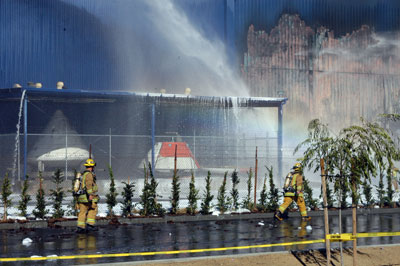 The two Apollo boilerplate capsules survive the fire largely undamaged. (credit: Gerald Blackburn, Aerospace Legacy Foundation) |
Building 290 contains Downey’s old high bay, and was once the site where the Apollo spacecraft underwent final assembly. A “high bay,” for those of you unfamiliar with aerospace jargon, is a building with a very high roof and an overhead crane allowing for large spacecraft to be assembled. Downey’s high bay has found a second life in the movie and television business because it allows for the construction of tall movie and television sets. A year or so ago a film production crew built a mineshaft set and mounted the camera on a high platform dozens of feet above the ground so that they could film Sandra Bullock down at the bottom. On this day a crew from the television series Bones was preparing to shoot scenes set inside a sinking ship. A construction crew had built several rooms of a ship out of plywood and painted them like the rusted interior of an old freighter, an illusion that holds up remarkably well even when you’re standing only inches away. At least part of the shot required water to poor down from above over one of the sets. Because it is uncomfortable, even dangerous, for actors to spend much time shooting in cold water, the film crew had set up several water heaters outside the building, about 10–15 meters from the boilerplates. The heaters warmed the water in a tank on the ground near the set and pumps then lifted the water up above the set so it could be sprayed down on the actors. Alongside the heaters were about half a dozen large propane tanks lined up against the wall. In the unusually warm and sunny southern Californian day, the propane tanks heated up and their pressure release valves popped.
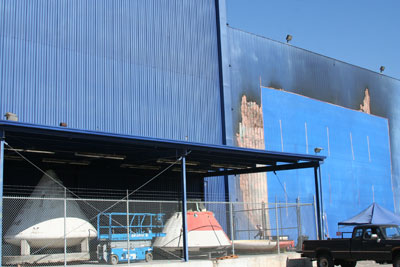 Repaired wall of Building 290 ten days after the November 7 fire. BP-12 is at left, BP-19 is at center. The blue tarp at right protects new propane tanks from the sun—something missing before the fire started. (credit: Dwayne Day) |
What happened next is unclear, but somehow an ignition source started a fire while most of the work crew was on their lunch break on the other side of the building. The result was several of these propane tanks firing straight up along the exterior wall of the building like blowtorches. Somebody called the fire department which responded with several trucks and 36 firefighters.
| Downey’s old high bay may disappear in the next few years, but the boilerplates will serve to preserve its legacy—better out in the open than packed away in a crate in a warehouse, and hopefully without any further drama. |
Fortunately nobody was hurt, and because the fire was outside the building and primarily directed straight up, the steel wall of the building buckled and melted a bit, but the fire did not spread and did not impact the structural integrity of the building. The Apollo boilerplates were also lucky. The radiated heat from the propane-fed fire only a dozen meters away was hot enough to set off the sprinkler system over the capsules, spraying them with fresh water. Some of the water did enter BP-19 through a hole in the top. The two capsules emerged intact, with no heat damage. Unfortunately, one private contractor was not so lucky. His pickup truck filled with tools was parked only a few feet away from the wall. The truck and tools were a total loss, and a week and a half later the contractor was still arguing with his insurance agent.
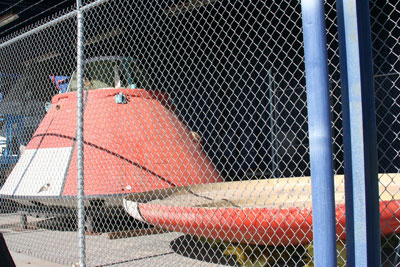 Apollo boilerplate 19. The bottom of the boilerplate filled with water which caused some minor damage to the fiberglass. (credit: Dwayne Day) |
Within days the damaged wall was patched, the water cleaned up, the debris hauled away, filming started and finished, and the sets torn down. Firefighters battle fires with water, but Hollywood fights intense television production schedules with money, filming the necessary scenes and then quickly leaving the site for the next project. Watch the upcoming episode of Bones for the result.
The boilerplates are scheduled for restoration. BP-19 will probably be displayed inside the nearby Columbia Memorial Space Science Learning Center scheduled to open in January. BP-12 will most likely end up outside, serving as a gate guardian for the Downey facility. The remaining Downey buildings like Building 290 may not last much longer. A lot of film production has migrated elsewhere, to central Europe, Vancouver, Louisiana, and even New Mexico. Movie companies also rarely need the kind of space that the Downey facility provides. Why build a massive set when you can simply simulate it all on a computer? Downey’s old high bay may disappear in the next few years, but the boilerplates will serve to preserve its legacy—better out in the open than packed away in a crate in a warehouse, and hopefully without any further drama.
 Apollo boilerplate 12, which sat outdoors for over three decades. (credit: Dwayne Day) |
